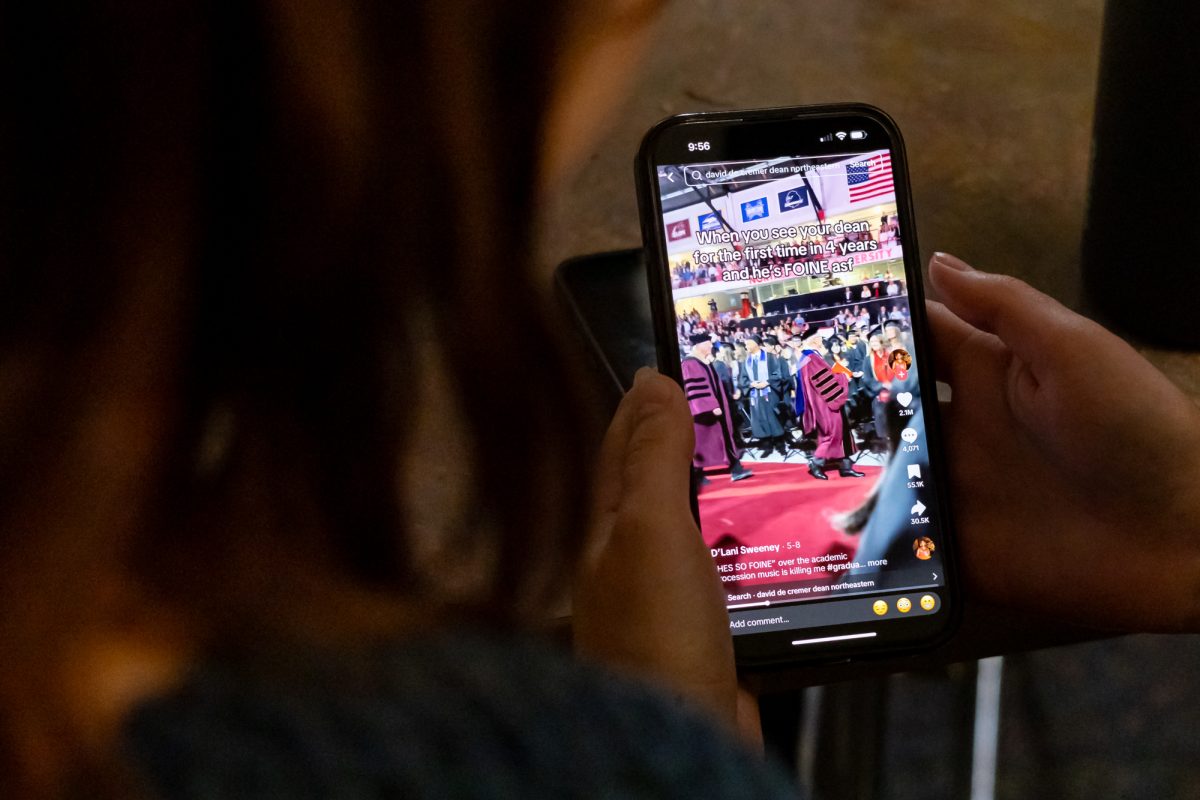
By Madelyn Stone, News Staff
Dark Venetian masks, 2-foot-long recorders, velvet-caped stilt dancers and a three-legged jester helped transport Renaissance-era arts to Northeastern Saturday night at a performance by Boston-based improvisational group Renaissonics.
Northeastern’s Italian Culture Society teamed up with the International Student and Scholar Institute (ISSI) to sponsor the festivities in the Fenway Center for an audience of more than 75 people. ISSI’s senior associate director, Sal Mazzone, said they hosted the event in celebration of Carnevale, an annual Italian cultural festival.
“During this time of year, February, you have the equivalent [in Italy] of Mardi Gras in New Orleans, with masks and so on,” he said.
Titled “Fantasia di Maschere,” or “Fantasy of Masks,” the event included several masked characters performing the long-established Italian theater known as commedia dell’arte, customarily a part of the Carnevale celebration. Traditional stock characters like the coquettish Columbina, the mischievous Arlecchino and the self-centered Pulcinella pranced around onstage with distinct costumes and often exaggerated guises.
“[Commedia dell’arte] really goes deep into history,” Mazzone said. “It’s really quite a thing. Each mask that you see is actually original, they go to particular region of Italy. It could be from the south, from the north, very different. I grew up with these masks, though I don’t remember the details. But it’s fascinating.”
Gina Maiellaro, a professor of Italian culture and the director of Italian programming, also grew up in Italy.
“We still use these masks – I mean, they’re still popular today when we celebrate Carnevale in Italy,” she said. “Kids still wear a costume of Columbina.”
The guises of characters like Arlecchino and Pulcinella are also popular among Italian children during Carnevale.
Chiara Durazzini, an independent Italian teacher, was one of three actors to perform in the show, portraying the roles of Columbina and Arleccino.
“The interesting thing about commedia is that it has stock characters,” she said. “Because when you were walking by a piazza and you would see comedians playing, you needed to recognize the characters right away. You didn’t have time to stop and learn the story or the psychology of the characters.”
Durazzini said she developed an appreciation for commedia dell’arte when studying drama at the University of Bologna.
“I have to say that I fell in love with commedia dell’arte, Italian comedy, because it’s very physical and I like the physicality,” she said. “And it’s fun. I mean I’m better in comedies than in drama, so I thought that that was my way, my passion. So I’ve been doing it since, on and off.”

Though several children had front row seats at the show, the comedy was not entirely innocent. At one point in the performance, Durazzini, who played Columbina, convinced an audience member to scratch an itch on the actor’s behind, just before scolding him with a sudden rebuke: “You’re fresh!”
“It may be a little weird,” Maillaro said. “She doing a lot of double entendre references to stuff, that is precisely what commedia dell’arte is. It’s full of that. In fact I was a little worried about it, but she did a good job. Everything was double meaning, you know there was a sexual underpinning. But that’s commedia dell’arte. The thing is that if you’re very young and you may not understand, it’s irrelevant, especially in the first scene when she does the itchy part. So that’s just itching, but then an adult’s like, ‘Well, yeah, but there’s something else there.’”
As much a part of the show as the acting, the music of the Renaissonics quartet provided an auditory perspective to 15th century Italian culture.
John Tyson, director of Renaissonics and a former artist in residence at Northeastern, played several different types of recorders during the performance along with the curved crumhorn instrument and the pipe and tabor.
“We started Renaissonics about 20-something years ago,” he said. “All the members of Renaissonics still play in pop groups and symphony orchestras and a little bit of everything, but all these meet in renaissance stuff. Renaissance music kind of doesn’t fit our categorizations. You can be playing really fine elegant chamber music and improvising at the same time. So it’s very much like a pop jazz band and a classical group, and you have to have the skills of both. It’s a funny combination.”
The Renaissonics have released one CD, Dance!, in the nineties, which they describe as what Louis Armstrong’s Hot Five would have sounded like had the jazz musician lived in the 16th century.
The improvisational method was a common theme through the performance.
“The actors worked on scenarios that was a basic storyline, and they were improvising more or less,” Durazzini said. “They were professionals but they improvised the dialogue. They didn’t have lines. So you cannot find a written commedia play, you find a scenario, like what the characters are doing and that’s it, the actions. In fact, I have no lines and you can tell sometimes.”
The audience seemed to enjoy the improvisational energy, said middler international affairs major Alessandra Munno.
“It was funny,” she said. “I liked the whole costume thing and the music a lot.”
The celebration of Carnevale will continue through March 31 at Northeastern, with events like the ISSI-sponsored Venetian mask ball this Saturday night at The Colonnade Hotel. Tickets to the formal dance are $20 and can be purchased on the myNEU portal.








